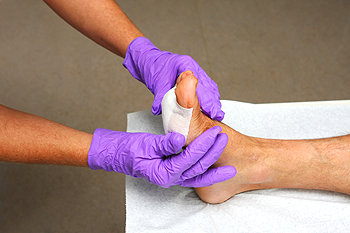(410) 764-7044
6506 Reisterstown Road, Baltimore
1205 York Road, Lutherville
6305 Belair Road, Baltimore
7809 Wise Avenue, Dundalk
June 2024
Treatment for Post-Traumatic Wounds of the Foot
 Post-traumatic wounds over the top part of the foot are injuries that occur after a traumatic event, such as an accident or severe impact. These wounds can be caused by cuts, crush injuries, or severe abrasions. When they happen, it is essential to treat them properly to prevent complications like infection or poor healing. Handling these wounds involves cleaning and dressing them to prevent infection. In more severe cases, where the skin and tissue are significantly damaged, podiatrists may use skin grafts, local tissue flaps, or free flaps for reconstruction. Skin grafts involve taking healthy skin from another part of the body to cover the wound, but they might not be as durable in the long term. Local or distant flaps are often preferred because they provide better long-term results and lower chances of permanent tightening of the skin. Reconstruction should focus on maintaining the foot's form, function, and appearance. If you have sustained such an injury, it is suggested that you schedule an appointment with a podiatrist for individualized treatment to achieve the best outcome.
Post-traumatic wounds over the top part of the foot are injuries that occur after a traumatic event, such as an accident or severe impact. These wounds can be caused by cuts, crush injuries, or severe abrasions. When they happen, it is essential to treat them properly to prevent complications like infection or poor healing. Handling these wounds involves cleaning and dressing them to prevent infection. In more severe cases, where the skin and tissue are significantly damaged, podiatrists may use skin grafts, local tissue flaps, or free flaps for reconstruction. Skin grafts involve taking healthy skin from another part of the body to cover the wound, but they might not be as durable in the long term. Local or distant flaps are often preferred because they provide better long-term results and lower chances of permanent tightening of the skin. Reconstruction should focus on maintaining the foot's form, function, and appearance. If you have sustained such an injury, it is suggested that you schedule an appointment with a podiatrist for individualized treatment to achieve the best outcome.
Wound care is an important part in dealing with diabetes. If you have diabetes and a foot wound or would like more information about wound care for diabetics, consult with one of our podiatrists from Plaza Podiatry. Our doctors will assess your condition and provide you with quality foot and ankle treatment.
What Is Wound Care?
Wound care is the practice of taking proper care of a wound. This can range from the smallest to the largest of wounds. While everyone can benefit from proper wound care, it is much more important for diabetics. Diabetics often suffer from poor blood circulation which causes wounds to heal much slower than they would in a non-diabetic.
What Is the Importance of Wound Care?
While it may not seem apparent with small ulcers on the foot, for diabetics, any size ulcer can become infected. Diabetics often also suffer from neuropathy, or nerve loss. This means they might not even feel when they have an ulcer on their foot. If the wound becomes severely infected, amputation may be necessary. Therefore, it is of the upmost importance to properly care for any and all foot wounds.
How to Care for Wounds
The best way to care for foot wounds is to prevent them. For diabetics, this means daily inspections of the feet for any signs of abnormalities or ulcers. It is also recommended to see a podiatrist several times a year for a foot inspection. If you do have an ulcer, run the wound under water to clear dirt from the wound; then apply antibiotic ointment to the wound and cover with a bandage. Bandages should be changed daily and keeping pressure off the wound is smart. It is advised to see a podiatrist, who can keep an eye on it.
If you have any questions, please feel free to contact our offices located in Baltimore, Lutherville, and Dundalk, MD . We offer the newest diagnostic and treatment technologies for all your foot care needs.
Symptoms and Causes of Ankle Bursitis

Ankle bursitis occurs when the bursae sacs in the ankle become inflamed, causing significant discomfort and mobility issues. Bursae are small, fluid-filled sacs that act as cushions between bones, tendons, and muscles, reducing friction and facilitating smooth joint movement. These sacs can become irritated or inflamed, typically due to overuse, trauma, infection, or medical conditions like gout or rheumatoid arthritis. Common symptoms of ankle bursitis include pain and tenderness in the ankle, swelling, stiffness, warmth, or redness around the affected area. Aching or throbbing pain also can occur, especially when pressure is applied. Overuse from activities like running or dancing, trauma from injuries, or wearing poorly fitting shoes are frequent causes. Proper diagnosis may include imaging tests like X-rays or MRIs to rule out other conditions. In some cases, fluid from the bursae might be tested for infections. If you're experiencing symptoms of ankle bursitis, it is suggested that you make an appointment with a podiatrist for a diagnosis and treatment.
Ankle pain can have many different causes and the pain may potentially be serious. If you have ankle pain, consult with one of our podiatrists from Plaza Podiatry. Our doctors will assess your condition and provide you with quality foot and ankle treatment.
Ankle pain is any condition that causes pain in the ankle. Due to the fact that the ankle consists of tendons, muscles, bones, and ligaments, ankle pain can come from a number of different conditions.
Causes
The most common causes of ankle pain include:
- Types of arthritis (rheumatoid, osteoarthritis, and gout)
- Ankle sprains
- Broken ankles
- Achilles tendinitis
- Achilles tendon rupture
- Stress fractures
- Tarsal tunnel syndrome
- Plantar fasciitis
Symptoms
Symptoms of ankle injury vary based upon the condition. Pain may include general pain and discomfort, swelling, aching, redness, bruising, burning or stabbing sensations, and/or loss of sensation.
Diagnosis
Due to the wide variety of potential causes of ankle pain, podiatrists will utilize a number of different methods to properly diagnose ankle pain. This can include asking for personal and family medical histories and of any recent injuries. Further diagnosis may include sensation tests, a physical examination, and potentially x-rays or other imaging tests.
Treatment
Just as the range of causes varies widely, so do treatments. Some more common treatments are rest, ice packs, keeping pressure off the foot, orthotics and braces, medication for inflammation and pain, and surgery.
If you have any questions, please feel free to contact our offices located in Baltimore, Lutherville, and Dundalk, MD . We offer the newest diagnostic and treatment technologies for all your foot care needs.
Fear of Falling Among Diabetics
 Diabetic foot problems and the fear of falling are significant concerns for individuals managing diabetes. Diabetes can lead to various complications, including neuropathy and peripheral vascular disease, or PAD, which affect sensation and blood flow to the feet. As a result, individuals with diabetes may experience decreased balance, altered gait, and diminished sensation, increasing their risk of falls. Furthermore, diabetic foot complications, such as foot ulcers and infections, can further impair mobility and increase the fear of falling. The fear of falls can lead to decreased physical activity and social isolation, impacting overall quality of life. To address these concerns effectively, it is suggested that individuals with diabetes include a podiatrist as part of their healthcare team. Podiatrists specialize in foot care and can assess and manage diabetic foot complications, provide preventive measures, and offer guidance to reduce the risk of falls.
Diabetic foot problems and the fear of falling are significant concerns for individuals managing diabetes. Diabetes can lead to various complications, including neuropathy and peripheral vascular disease, or PAD, which affect sensation and blood flow to the feet. As a result, individuals with diabetes may experience decreased balance, altered gait, and diminished sensation, increasing their risk of falls. Furthermore, diabetic foot complications, such as foot ulcers and infections, can further impair mobility and increase the fear of falling. The fear of falls can lead to decreased physical activity and social isolation, impacting overall quality of life. To address these concerns effectively, it is suggested that individuals with diabetes include a podiatrist as part of their healthcare team. Podiatrists specialize in foot care and can assess and manage diabetic foot complications, provide preventive measures, and offer guidance to reduce the risk of falls.
Diabetic foot care is important in preventing foot ailments such as ulcers. If you are suffering from diabetes or have any other concerns about your feet, contact one of our podiatrists from Plaza Podiatry. Our doctors can provide the care you need to keep you pain-free and on your feet.
Diabetic Foot Care
Diabetes affects millions of people every year. The condition can damage blood vessels in many parts of the body, especially the feet. Because of this, taking care of your feet is essential if you have diabetes, and having a podiatrist help monitor your foot health is highly recommended.
The Importance of Caring for Your Feet
- Routinely inspect your feet for bruises or sores.
- Wear socks that fit your feet comfortably.
- Wear comfortable shoes that provide adequate support.
Patients with diabetes should have their doctor monitor their blood levels, as blood sugar levels play such a huge role in diabetic care. Monitoring these levels on a regular basis is highly advised.
It is always best to inform your healthcare professional of any concerns you may have regarding your feet, especially for diabetic patients. Early treatment and routine foot examinations are keys to maintaining proper health, especially because severe complications can arise if proper treatment is not applied.
If you have any questions please feel free to contact our offices located in Baltimore, Lutherville, and Dundalk, MD . We offer the newest diagnostic and treatment technologies for all your foot and ankle needs.
Are You Suffering From Ingrown Toenails?
The Benefits of Ankle Stretches

Ankle stretches play a pivotal role in maintaining optimal foot and lower limb health, offering a multitude of benefits for individuals of all ages and activity levels. These stretches help improve ankle flexibility, range of motion, and proprioception, reducing the risk of injuries such as sprains and strains. Additionally, ankle stretches alleviate tightness in the calf muscles and Achilles tendon, promoting better posture and gait mechanics. Performing ankle stretches can also enhance balance and stability, vital for activities like walking, running, and sports participation. To perform a basic ankle stretch, sit on the floor with your legs extended, then loop a resistance band or towel around the ball of one foot and gently pull it toward you, feeling a stretch in the calf and ankle. Hold the stretch for 15 to 30 seconds, then switch sides. Another effective stretch involves standing with one foot behind the other, bending the back knee slightly to stretch the calf and ankle. By incorporating these stretches into a regular routine, individuals can reap the benefits of improved ankle flexibility and function. If you have foot pain that may be impacted from having stiff ankles, it is suggested that you visit a podiatrist.
Stretching the feet is a great way to prevent injuries. If you have any concerns with your feet consult with one of our podiatrists from Plaza Podiatry. Our doctors will assess your condition and provide you with quality foot and ankle treatment.
Stretching the Feet
Stretching the muscles in the foot is an important part in any physical activity. Feet that are tight can lead to less flexibility and make you more prone to injury. One of the most common forms of foot pain, plantar fasciitis, can be stretched out to help ease the pain. Stretching can not only ease pain from plantar fasciitis but also prevent it as well. However, it is important to see a podiatrist first if stretching is right for you. Podiatrists can also recommend other ways to stretch your feet. Once you know whether stretching is right for you, here are some excellent stretches you can do.
- Using a foam roller or any cylindrical object (a water bottle or soda can will do), roll the object under your foot back and forth. You should also exert pressure on the object. Be sure to do this to both feet for a minute. Do this exercise three times each.
- Similar to the previous one, take a ball, such as a tennis ball, and roll it under your foot while seated and exert pressure on it.
- Grab a resistance band or towel and take a seat. If you are using a towel, fold it length wise. Next put either one between the ball of your foot and heel and pull with both hands on each side towards you. Hold this for 15 seconds and then switch feet. Do this three times for each foot.
- Finally hold your big toe while crossing one leg over the other. Pull the toe towards you and hold for 15 seconds. Once again do this three times per foot.
It is best to go easy when first stretching your foot and work your way up. If your foot starts hurting, stop exercising and ice and rest the foot. It is advised to then see a podiatrist for help.
If you have any questions, please feel free to contact our offices located in Baltimore, Lutherville, and Dundalk, MD . We offer the newest diagnostic and treatment technologies for all your foot care needs.





